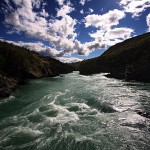
Mr. Director:
After traveling the world analyzing how countries are solving the issue of water scarcity (which happens in 40% of the continental global territory), I write these lines very humbly, but also as someone who understands the matter, to give the guidelines that the next government should follow, in order to solve once and for all the water problem that Chile faces (which will continue to griev and which we can no longer ignore). We have many problems (social crisis, economic crisis, pandemic, etc.), but the water crisis is the most important of them, because without water we cannot function as a country.
In this regard, what should be done in the next mandate is simple and includes the following (to be applied individually in each of the 101 macro-schools in Chile and its respective micro-schools):
1- Meter law. As in family consumption (e.g. a house in Santiago), anyone using water must have a state-run meter, including norias, wells, river and canal diversions, etc. If we don’t know exactly how much is being consumed in a basin, the problem cannot be solved, and the truth is that we don’t know.
2- Hydrological modeling and research. If we do not understand how the basin responds hydrologically with the arrival of different areas, we cannot manage water sustainably in the territory, nor make decisions of land use changes. For this, research is required based on strong instrumentation, in order to be able to automatically and in real time measure precipitation, temperatures, evapotranspiration, surface flows, aquifer responses, consumptions and other hydrological variables, including also climate change, future demands and volumes of water import.
3- Territorial planning. Fundamental to the sustainable use of the resource at the basin level (what, how much and where to grow, in order to ensure the sustainability of the resource and avoid social and environmental problems). The same applies for mining, industry and urbanization.
4- Water reuse. The countries that have solved the problem are characterized by not losing a single drop, so it is essential to treat and reuse sewage, wastewater from mining and other industrial processes, and to allocate it to other uses (technologies are and are not expensive). In many countries, mining has been transformed into power plants and agriculture is supplied with treated sewage (these are just examples).
5- Import and storage of water in basins. Due to the effects of climate change, measures such as the construction of reservoirs are technically unviable, thanks to the Andean glaciers melting in leaps and bounds. Therefore, global experience indicates that desalination is the most feasible solution for Chile, where a desalination plant is installed on the coast that treats seawater for mining use, which is piped and transported within the macro-water, forking into each micro-water, where state-of-the-art solar desalination plants are installed that treat water for four main uses : agricultural irrigation, municipal irrigation, recovery of aquatic ecosystems destroyed thanks to over-otorgation of water use rights, and recharge of aquifers (the latter to recover the hundreds of thousands of norias that have dried up due to the overconsuming of groundwater). It is important to mention that brine (process residue) should be poured away from the coast (in the Humboldt stream, which is losing salinity due to the melting of the South Pole), to avoid environmental problems in our marine ecosystems. Comment: the controversial “water road” is not ecologically viable and also does not solve the underside problem, as it is an irrigation project, and these volumes can be obtained from the sea locally through sustainable desalination.
6- Efficiency in irrigation. More incentives should be urgently generated for the application of technified irrigation, the use of hydrogels (which reduce irrigation by up to 90%) and evaporation control. Agriculture is the great consumer of water in Chile, but that can easily change if we are efficient. In fact, domestic agricultural production could be tripled, using a share of the water that is now intended for the item. If the way we currently produce food is not changed, we will continue to be closed to international markets.
7- Water conflict resolution. Eprovide efficient methodologies that ensure an agreement between parties. If not all the joined actors work, nothing is solved in a basin, as seen in cases like Aculeo.
8- Recruitment of hydrologists. Each change in land use within a basin must be studied and approved by a hydrologist, in order to ensure the availability of the resource for other uses (e.g. small and large agriculture, drinking water, ecosystems, mining, etc.), also managing a water resource management plan for the basin. It is important to mention that a civil engineer with mention in water resources (who sees intubations, dams, pipelines, etc.) is not the same as a hydrologist (who studies the water cycle in a given basin, from precipitation to its exit to the sea, either superficially or underground, considering consumption, geology, topography, climate, soils, climate change, etc.). Therefore, it is essential to train hydrologists in Chile and their hiring within the institutions involved with water management, including municipalities.
9- Creation of education programs for water care. This applies not only to schools, but also universities, companies, public institutions, etc. A population that cares for its water is essential to minimize municipal consumption, and in Chile today there is no water culture.
10- Creation of incentive and investment programs for families without access to water. This is necessary for the installation of rainwater collection systems on waterproof surfaces such as roofs, parking lots, greenlands and streets, as well as a system that finances the diversion of grey water and the transformation of English gardens (grass) to xerojardines, etc. At the same time, it is important to replace the unworthy and expensive cistern trucks with the latest generation solar machines that can produce hundreds of liters per day of pure water, condensing moisture in the atmosphere (central Chile has the right conditions, as relative humidity borders 80%, and at least 30% is needed).
11- Water deprivatization. It is impossible to efficiently manage water in a water-scarce basin that has privatized the resource. It is strictly necessary to deprivatize blue gold, but at the same time ensure recourse to those who currently use it, and that is where efficiency enters and all other points above. Once the water is depressed, it can be properly managed in the basin.
Pablo Garcia-Chevesich.
Hydrologist, UNESCO Water Expert and academic Colorado School of Mines and University of Arizona.





